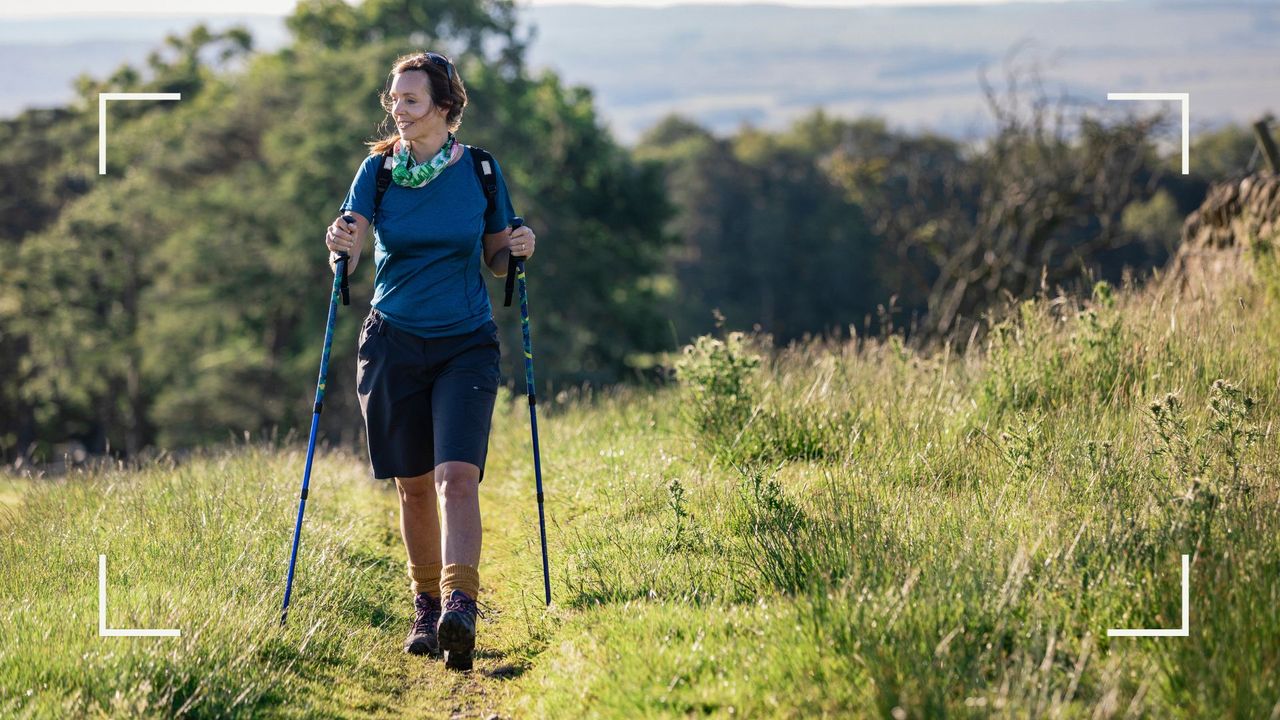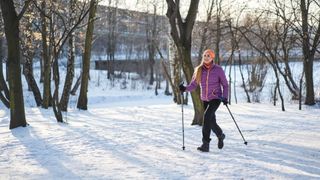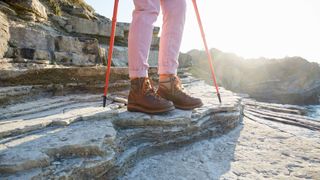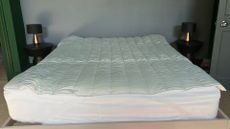Nordic walking for beginners: Discover the benefits, how to get started, and mistakes to avoid
Nordic walking will take your walks to the next level while supporting your joints and heart health


Lauren Clark
If you've ever seen hikers striding across a hill with poles in their hands, you already know what Nordic walking is. The sport, made popular in the 1990s by the Finnish cross-country skiing team, has been growing in popularity in recent years thanks to its versatile nature and accessible beginner clubs.
Another reason for the growth in Nordic walkers is the amazing benefits the activity offers. Everything from improving your overall cardiovascular fitness to helping you maintain your posture and improve your core strength, there's almost no part of the body that Nordic walking doesn't positively impact in some way.
All you need to get started is a pair of the best walking boots, some walking poles, and some tips and advice for beginners from the founder and instructor of one of the most popular Nordic walking groups in the UK.
What is Nordic walking?
Nordic walking is a technique that delivers a full-body workout outdoors, explains Katharine Green, an INWA Nordic walking instructor with qualifications in fitness walking. "Typically, you use specially-designed Nordic walking poles which are attached to the hands via a strap and angled behind you as you walk, so you can propel yourself forward," she explains.
Green, who also runs Nordic Walking East Anglia, also stresses that despite its appearance, Nordic walking is suitable for all fitness levels and age ranges. "Much like power walking, the activity has changed over the years and it can be easily adapted to anyone, based on their activity levels and what they want out of Nordic walking."
The activity came from Finland originally, as the name suggests, and became a popular sport in the 1990s as elite cross-country skiers began to use the poles in their summer training programs. Thanks to its accessibility and the invention of the best walking poles by Excel in 1997, it's continued to be popular ever since with a reported 10 million people taking to the hills every year, according to data from Exe Nordic Walking.

What are the benefits of Nordic walking?
1. Nordic walking is a low-impact activity
Nordic walking is a lower-impact activity, much like soft hiking, meaning you can reap all the benefits of cardiovascular exercise without having to stress out your joints. "With poles, you're basically turned into a four-legged animal. Your weight is spread across all four limbs, which reduces the impact force going through the leg joints, which therefore lower the risk of back, neck, and knee pain over time," Green explains.
Sign up for the woman&home newsletter
Sign up to our free daily email for the latest royal and entertainment news, interesting opinion, expert advice on styling and beauty trends, and no-nonsense guides to the health and wellness questions you want answered.
If you're wondering 'is walking good exercise generally?' then we have some good news. This is also one of the many benefits of walking, however, as research from the University School of Physical Education in Poland shows there's not actually too much difference between Nordic walking and strolling in general. Walking and hiking is a lot lower impact than other cardio activities like running, while at the same time, it offers some impact on the joints which helps to reduce the risk of conditions like osteoporosis.
2. Improves cardiovascular health
As with any cardio exercise, one of the key benefits of Nordic walking is the advantages it can offer for your cardiovascular health. We feel this as we get out of breath on a walk but there are also studies to support the idea. In a review of studies looking at those with heart disease, the University of Cagliari found that participants who did Nordic walking over standard rehab programs had significantly improved exercise capacity, could exercise for longer, and had higher oxygen uptake.
While another from the Institute of Cardiology in Poland, looking at heart failure patients, noted that the lung capacity (VO2 max) of those who did Nordic walking after a 6-minute walking test was significantly higher than others.
Good cardiovascular health is important as it leads to lower blood pressure, a reduction in bad cholesterol (LDL), an increase in good cholesterol (HDL), and is linked to a lower risk of obesity. All of which, for most people, leads to a lower risk of adverse health conditions like heart disease, stroke, diabetes, and more.
3. Build better posture
Typically when walking up a hill or an incline, we bend over slightly or hunch our shoulders toward our ears. The support offered by the Nordic walking poles prevents us from doing this and as our spine rotates slightly when we plant the poles and lift off again, it improves core strength which is also vital in maintaining a good posture.
Not only this, Green explains, "The continual contraction and relaxation of the neck and shoulder muscles leads to reduced tension in those areas, so there's also an emphasis on building good posture with this."

4. Counteract the symptoms of menopause
A lesser-known menopause symptom is the gradual decline of muscle mass and bone density. While we often associate menopause with being one of the causes of hot flashes and other physical symptoms, this is a side effect that can also have a significant impact on your overall health.
"Nordic walking is particularly helpful during perimenopause and menopause," says Green. "Estrogen deficiency, which happens at this stage, is associated with decreased skeletal muscle and strength, which this type of walking movement can help to counteract."
5. Nordic walking can help you lose weight
Weight loss won't be everyone's goal when it comes to Nordic walking, but if you're looking for healthy ways to lose weight then it's certainly something to consider as this particular style of hiking is an incredible full-body exercise. As a type of LISS cardio training, it looks like quite an effortless activity but you'll use almost all the muscles in your body to do it. And with more muscle use comes higher calorie burn and with this comes a higher chance of getting into, and staying in, a calorie deficit.
"You'll enlist 90% of major muscles, compared to the 45% of regular walking, and will burn around 46% more energy because the muscles in both the upper and lower body are all under tension at the same time, meaning the calorie burn is higher for every step," Green says.
Plus, Nordic walking could be a great exercise to explore if you want to know how to lose weight without dieting. Research from the Jerzy Kukuczka Academy of Physical Education shows that Nordic walking alone can be a great tool for weight loss, as study participants showed an average 5kg loss in weight as they started exercising with walking poles without any diet changes. Those on a modified diet lost even more weight over the 12-week period, as their deficit would naturally have been bigger, but only by 3kg.
While weight loss and achieving a good overall level of fitness are different health goals, if you are looking to learn how to lose weight then Nordic walking can help to increase the number of calories burned walking.

6. It's a social sport
Let's also not forget that - unlike going to the gym or doing a workout form home - Nordic walking is normally done as part of a group, bringing an extra social element to this form of exercise.
"It is important to highlight the mood and energy-boosting benefits of being outdoors, which can help people learn how to deal with stress and lowers blood pressure,” adds Green. “Anyone can give it a go, and many people also enjoy a self-confidence boost from learning a new skill.”
How to start Nordic walking
1. Find a qualified instructor
"It is best to seek tuition from a qualified instructor, since it is hard to know if you are using the correct muscles without their guidance and feedback," says Green. "They'll teach you how to angle the poles, use a straight arm swing, utilize the straps or ledge, and roll through from the heels to toe as you plant the foot."
She recommends visiting the Nordic Walking UK website and using your postcode to find walks and instructors in your area.
Green says you can also find a qualified instructor local to you by visiting the British Nordic Walking's ‘find an instructor’ page. She explains that they will be able to teach the International Nordic Walking Federation's 10-step technique, which research has shown to be particularly beneficial. "You can usually learn them in a four-hour workshop, or about six weekly lessons," she explains. "Joining a friendly, encouraging walking club will also help it become a regular lifestyle habit."
2. Get the right poles
To start with Nordic walking, you'll need a pair of hiking boots, shoes, and a set of poles. "These needs to be specific for Nordic walking and are not to be confused with poles with loop straps," says Green.
"You'll know you've got the right ones if they have a glove-like strap or a power core ledge, both of which allow you to push into them to propel yourself forward. This isn't possible with typical walking or hiking poles. Nordic walking poles will also have a removable rubber boot of sorts on the bottom that enables you to use the pole at the correct angle on hard surfaces and the poles should be light and strong," she explains.
As a beginner, it's worth getting to grips (literally) with the activity before you take the plunge and buy your own though. "Instructors are usually happy to lend out poles and it is advisable to borrow from them until you are happy with the length of pole that suits you best. Doing so also allows you to try a couple of different brands too, since they have slightly varying styles of straps," says the instructor.
3. Master the correct technique
There are a couple of pitfalls to be aware of. "The first common mistake is what we call tick-tocking, which is swinging the arm forward at the same time as the same leg. Normal walking is a bilateral movement, meaning opposite arm moves in time with the opposite leg," explains Green.
"The other is that people tend to bend at the elbow and engage their biceps, which is what we all do in normal life when we pick an object up. However, since Nordic walking is an extension of normal walking, the movement should come from the shoulder socket, so we always encourage beginners to imagine that their arm is a pendulum swinging from the shoulder. This enables a clear swing of the pole and ensures that the upper body is engaged effectively."
However, much like when you ride a bike or learn to swim, it's best not to overthink it. "The full technique does take a while to master and there is a lot to take on board at the start," notes Green. "We remind clients to focus on progression not perfection. When it comes to practicing alone, we tell people to focus on one technique point per walk, in order to consolidate the muscle memory for that particular movement."
4. Stay safe
"Other than the poles, you should have weather-appropriate footwear and clothing and learn how to keep your feet warm, because it is, after all, an outdoor activity," insists Williams. You should invest in a pair of hiking boots, as noted, and a pick of the best walking socks if you're considering taking up Nordic walking for the long haul, especially as there will be times when you won't be able to use your poles.
"The only time we do not venture out with poles is when there’s thunder and lightning, for obvious reasons," says Williams.
5. Go in a group
Nordic walking can, of course, be done solo. "You can walk pretty much anywhere urban or rural," explains Stewart. "But there are additional skills to master in relation to hill walking, so that’s why it’s good to be in a group. The instructors pre-plan the routes according to your ability, making sure it's safe and at the right degree of difficulty."
She adds, "If you do go on your own, it’s important to wear bright clothing, let others know where you are going and make sure you know the route so you don’t get lost."

Grace Walsh is woman&home's Health Channel Editor, working across the areas of fitness, nutrition, sleep, mental health, relationships, and sex. She is also a qualified fitness instructor. In 2025, she will be taking on her third marathon in Brighton, completing her first ultra marathon, and qualifying as a certified personal trainer and nutrition coach.
A digital journalist with over seven years experience as a writer and editor for UK publications, Grace has covered (almost) everything in the world of health and wellbeing with bylines in Cosmopolitan, Red, The i Paper, GoodtoKnow, and more.
- Lauren ClarkFreelance writer and editor
-
 Let me introduce Floks' cooling mattress topper - it's the best natural bedding I've tested
Let me introduce Floks' cooling mattress topper - it's the best natural bedding I've testedThe Floks Wool Mattress Topper is a natural, cooling, luxury mattress topper that suits sensitive skins, hot sleepers, and much more. It's a dream to sleep on.
By Laura Honey Published
-
 Kate Middleton's Mother's Day post has poignant detail that's easy to miss as Princess steps away from tradition
Kate Middleton's Mother's Day post has poignant detail that's easy to miss as Princess steps away from traditionThe Princess of Wales shared a video for Mother's Day this year and it included a detail that reminded us of a pivotal moment for her
By Emma Shacklock Published